Hey, how’s it going? Adam here bringing you another Irish Setter boot review. Today we are going to do an in-depth review of the Ashby boot (safety toe version) and see how it stacks up as a work boot and what its strengths and weaknesses are.
In A Rush?!
Reviewing The Irish Setter Ashby Safety Toe Work Boots
If you don’t have time to read my full review at the moment, here’s aTL: DR: So far I love them, and if you walk or stand a lot on concrete surfaces as I do, these boots provide phenomenal comfort.

But before we get into that, I would like to give you some history about the brand. However, if you are not a boot nerd like myself feel free to use the table of contents to skip ahead to the review.
What's Inside?
- Reviewing The Irish Setter Ashby Safety Toe Work Boots
- A quick intro to the Irish Setter brand
- Enter the Irish Setter Ashby boot
- The environment in which the boots are tested
- Unboxing the Irish Setter Ashby safety boots
- Irish Setter Ashby safety boots features
- The outside of the Irish Setter Asby work boots
- Inside the Irish Setter Ashby work boots
- Sizing and how do they fit?
- Are they comfortable? Do they need to break in?
- Are they waterproof?
- Will the Irish Setter fit wide feet?
- Are they slippery?
- Where are they made?
- What others are saying about the Irish Setter Ashby boot?
- Where to buy them?
- Irish Setter Ashby work boots models available
- Some initial concerns
- Watch the Ashby review on YouTube
- Ashby compared to Wingshooter
- Last thoughts on these Irish Setter Ashby work boots
- Overall, A Very Comfortable Work Boot
- Update: Wearing the Irish Setter Ashby for 1 month
- Update: Wearing the Irish Setter Ashby for 6 months
I’d also like to give a special thanks to Jaden with Red Wing for providing us with some very helpful information for this review.
Who’s working on this page

Adam Rich
Author & Researcher

Jaden Chavez
Boot Collector & Enthusiast

Victor Adrian
Researcher & Editor
A quick intro to the Irish Setter brand
For those of you who don’t know. Irish Setter is owned by Red Wing Shoe Company. In fact, the current flagship and world-famous 875 and 877 heritage boots were once Irish Setters.
In 1950 Red Wing introduced a 9 inch lace up sportsman boot, style 854, for hunters in the now world-famous Oro-Russet color that the 875s and 877s come in.
That Oro-Russet color was the inspiration behind the name Irish Setter because, well, it looks like the color of the fur on an Irish Setter dog.
As you may have guessed it, that 9in 854 style boot was essentially today’s 877 with a heel.

In 1952 style 877 was born, replacing its forerunner the 854, the 877 that we have all come to know as one of Red Wing’s flagship boots kept the Moc Toe but replaced heel for a wedge sole.

As time went on the Irish Setter line evolved and grew and became a world-renowned hunting boot line.

Enter the Irish Setter Ashby boot
The Ashby boot gets its name from Ashby, Minnesota.
Redwing has a tradition of naming its Irish Setter work boots after towns in Minnesota as a way to pay homage to the hard-working men and women of Minnesota.
In fact, many of the Irish Setter work boots are named after small towns in Minnesota.
The Ashby was one of the first work boots made under the Irish Setter brand and named after the town of Ashby because of its strong manufacturing industry.
The environment in which the boots are tested
Before we go into the review I’d like to share with you the type of environment I’ll be working in when wearing these boots. This is very helpful when it comes to choosing the right boot for your work.
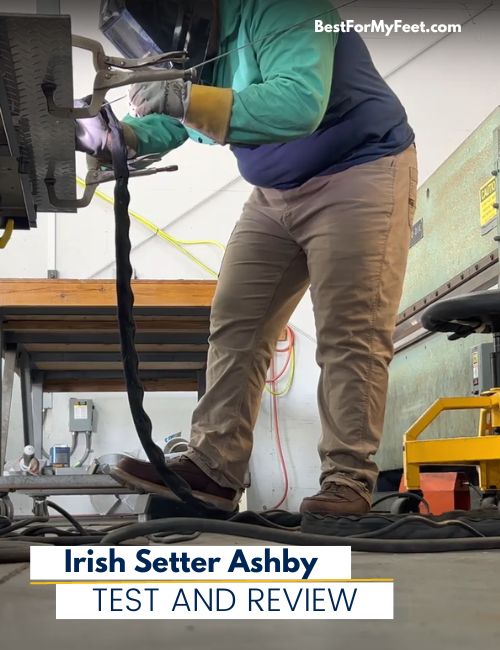
I’m in welding and sheet metal fabrication so some of the hazards these boots will face are abrasions and gouges (lots of sharp and pointy objects at the shop).
Walking around on metal shavings and being exposed to sparks and splatter from welding, grinding, and plasma cutting.
Why do I think they’ll be good? The wedge sole. I’m on concrete floors all day.
For me comfort is key and a wedge sole is typically more comfortable than a boot with a heel in this type of environment.
Unboxing the Irish Setter Ashby safety boots

On the outside of the box, you’ll be greeted by the iconic Irish Setter dog logo.
When you open the box you’ll be greeted by probably the highest quality leather you’ll find on a boot under $200, and even some over $200!!!
Irish Setter Ashby safety boots features
| Model number | STYLE 83606 |
| Toe cap | Aluminum safety cap |
| ASTM Standard: | ASTM F2413-18, M/I/C, EH |
| Leather type | Full grain, oiled |
| Height | 6-inch (available on 9″ pull-on) |
| Waterproof | Not waterproof |
| Construction | Goodyear PVC welt |
| Footbed | Removable PU insoles |
| Last | 325/IS-108H |
| Outsole | Rubber-EVA Traction Tred |
| Weight | 1lbs 13oz (822 grams) per boot |
The outside of the Irish Setter Asby work boots
Let’s check out some of the most important components on the exterior of these boots.
The leather on these work boots
The leather on this boot is one of its greatest features. The boot features Trout Brook leather, named after the brook that runs behind none other than Red Wing’s very own S.B. Foot Tanning company.
That’s right the leather on the Ashby is USA made from US raised steers at the same tannery that makes the leather for the Red Wing heritage boots.
Redwing/Irish Setter doesn’t have a name for the color of the leather the Ashby has so I’ve decided it’s unofficially going to be called Jerkey.
The guys at IrishSetterBoots actually liked the idea when I shared this post on Instagram…
The leather is absolutely amazing! It’s soft, supple oily, and has a very premium feel one would expect on a boot in the $250-$300 price range. And the best part is you can find the Ashby work boot for less than $200.
Extra stitches to extend durability
Starting from the bottom and working up we have the toe stitching.
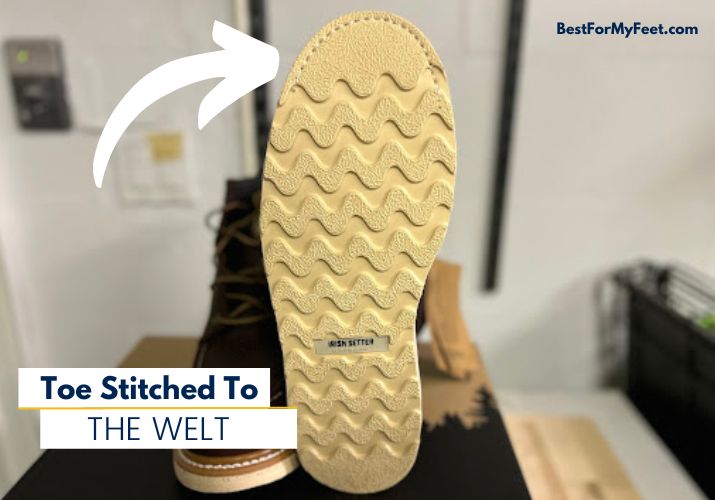
Having the toe area stitched to the welt is a must-have feature if you spend a lot of time at work on your knees and dragging your toes around.
The toe stitching helps prevent what you can see in the image below and keeps your boots going for longer even if the outsole delaminates at the toes.
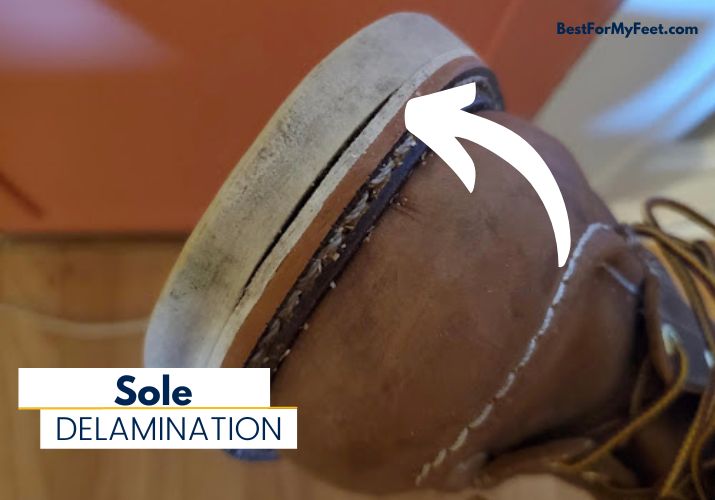
The outsole
The outsole on these boots is one of the more interesting features they have. It’s a Rubber-Eva Traction treaded outsole.
Meaning that these have an EVA midsole with another thick layer of EVA material followed by a thin rubber traction red layer.
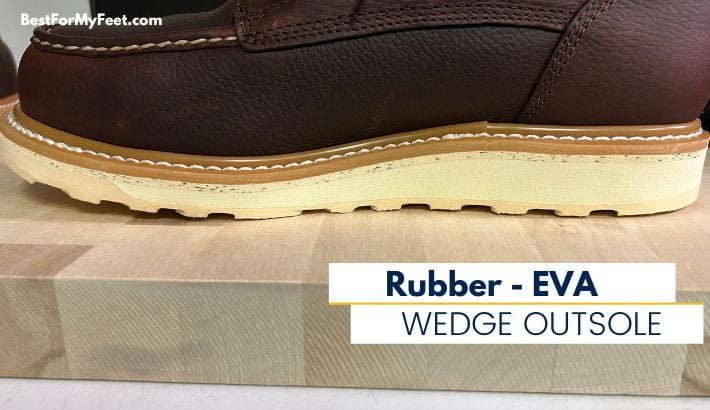
They did a really good job at blending in athletic shoe tech without making the boot look like one of those tennis shoe/boot hybrid abominations.
It definitely adds to the comfort level and feels more comfortable than a traditional wedge sole work boot.
The outsole is also heat resistant up to 475°. Meaning you can safely walk on material or surface up to 475° before the outsole begins to melt.
They also meet ASTM safety standards for electrical hazards so they can be a great pair of work boots for electricians.
The outsole also meets ASTM F3445-2 requirements for slip resistance.
Slip resistance standards haven’t been around very long in the US. It was introduced in July of 2021 and establishes the minimum coefficient of friction requirements to label footwear as slip resistant.
If you would like to go down the rabbit hole this website has an excellent article on the subject.
Sole thickness and heel height
The outsole is 1.25 inches thick at the heel and .750 inches thick at the ball of the foot.

The welt
The Goodyear welt we see on these is a synthetic welt made of PVC. This doesn’t mean that the boot is cheaply made or it’s low quality.
Many more expensive work boots brands, such as Thorogood, also use synthetic welt instead of leather.
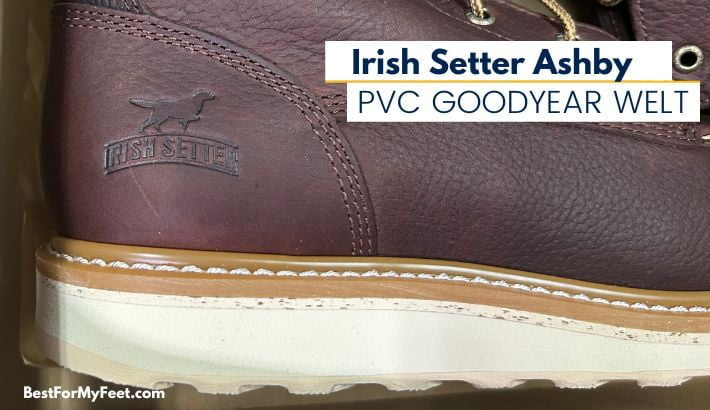
If there is one con to this type of material used in Goodyear welted work boots, is that the welt tends to crack faster than if it’s made out of leather.
The tox box
The toe box comes in just under 4 inches and is the same as the WingShooter ST we recently reviewed.
Considering this boot only has a thin moisture-wicking liner in it, the boots have plenty of wiggle room for your toes. I’m able to move and wiggle my toes around freely.
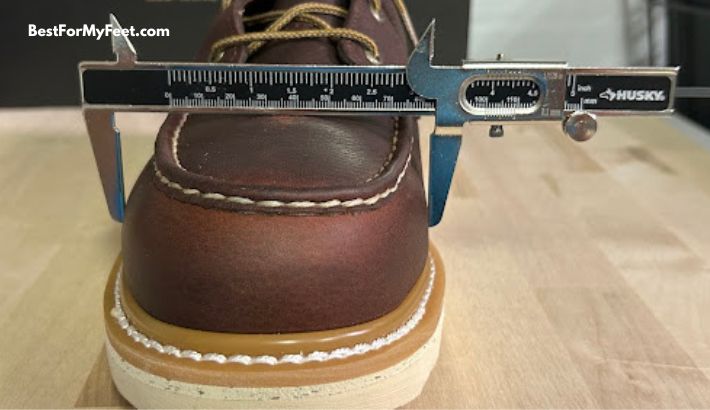
Tongue (not gusseted)
These do not have a gusseted tongue. It’s not necessarily a bad thing.
Many leather boots that have a gusseted tongue require you to train the tongue and make sure it’s positioned correctly when you lace up.
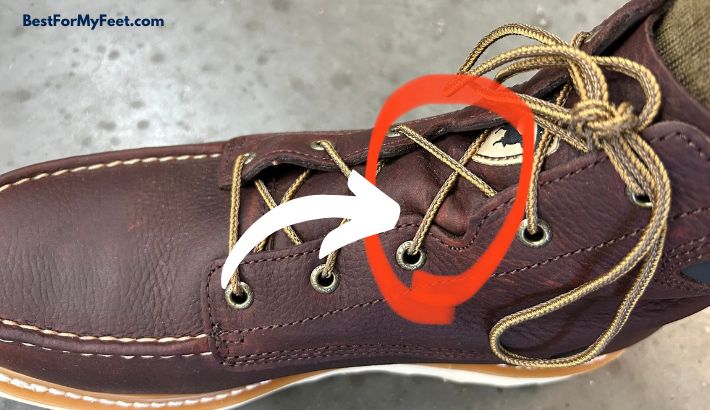
If you don’t, the tongue won’t crease in the correct spot of the gusset causing your tongue to be crooked when the boots are laced up.
No gusset means you don’t have to worry about that.
But the lack of gusset could allow dirt and debris into the boot and you’ll most likely end up with wet socks if you accidentally step into a deep puddle.
Even if a boot isn’t waterproof, having a gusseted tongue will add some protection from stepping in a puddle. By the way, learn here how to waterproof your work boots if you’re new to work boots.
Padded collar
At the top, we have a nice thick layer of padding around the back side of the boot to help keep them comfortable when laced tightly.
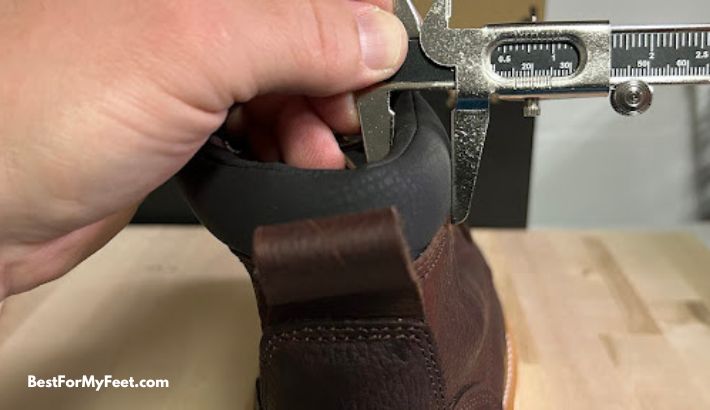
Inside the Irish Setter Ashby work boots
Now let’s move on to the inner parts of these work boots and see what we can find.
Padded tongue
Moving on to the inside of the boot we have the tongue again…
On the underside of the tongue, you’ll find the label with the boots’ safety rating along with size and country of origin.
You’ll also notice it has a thin layer of padding stitched to the underside.
The padding is helpful because it gives you an extra layer of protection when lacing your boots tight and prevents the eyelets and laces from digging into the top of your foot.
Lining
The black material the left arrow is pointing at is a thin moisture-wicking lining that helps to keep your feet dry. The lining runs down the sides and across the top in the toe areas.
But the moisture-wicking fabric is minimal in this so you can’t really say that this is a lined work boot.
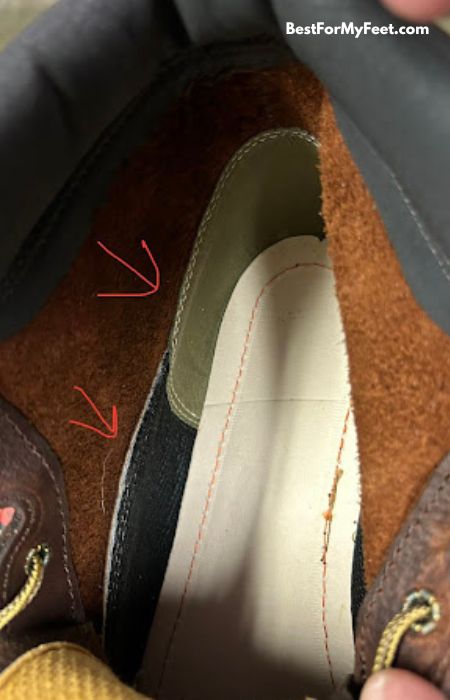
The green material is the heel counter, which I believe is some type of fiberboard material but I’m not sure. It’s definitely not suede or leather.
Footbed and insole
The insole is a single-density PU insole that is pretty comfortable. It’s not the best footbed I’ve had in a boot but it’s comfortable enough to go all day.
Below that we have a Texon insole. Unfortunately, I can’t tell you which Texon insole it is but Texon supplies a lot of companies with insoles. Texon is a cellulose fiberboard material.

Our friend Jaden with Redwing tells me the padding you see stitched into the front of the insole, in the ball area (pic on the right -2-), is there to help prevent wear at the flex point which can be common with fiberboard insoles.
Toe box – Is there a safety toe inside this boot?
Yep there sure is!
These Ashby boots have an aluminum safety toe cap which is wide enough to give your toes wiggle room along with protecting them while keeping the boot lightweight.
This brings us to our next point…
Are they heavy? How much do these boots weigh?
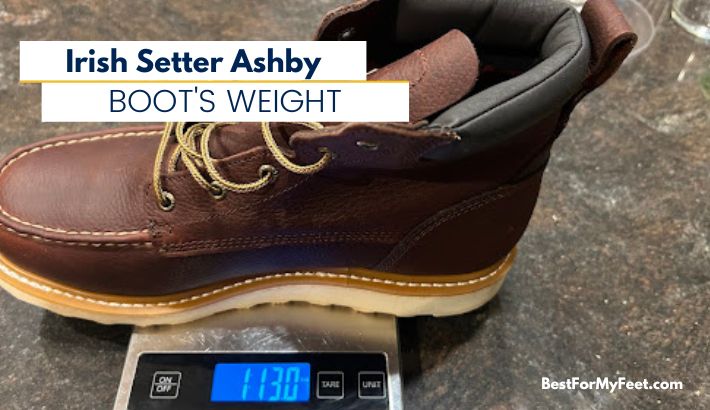
The Ashby boots weigh in at 1lbs 13oz per boot which is extremely lightweight for a work boot with a safety toe.
Please note the size tested is 11.5D so the weight will go up or down depending on your foot size.
Arch and ankle support
These have fairly decent ankle support. Not quite as good as some other boots but they definitely get the job done.
Now for arch support, the Ashby has great arch support built in.
This is great for people with medium to high arches as you may not need to replace the footbed with an expensive after-market insole. Below is a photo where I have highlighted the built-in arch support.
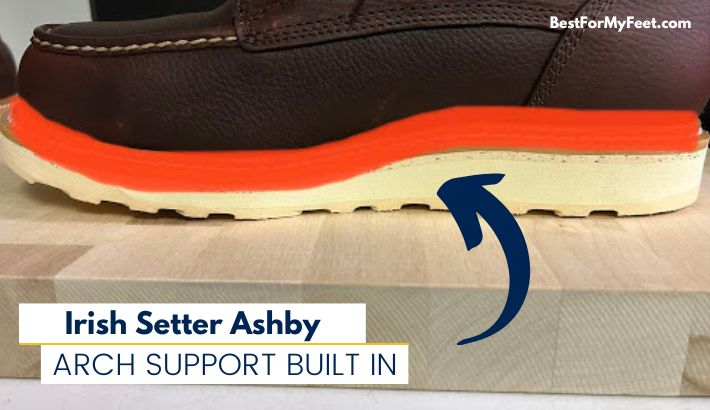
Sizing and how do they fit?
Now on to sizing. For me personally, the Ashby is true to size.
The Redwing foot scanner had me sized at 11.5 and the 11.5 I purchased fit me perfectly.
Our friend Jaden with Redwing did inform me that the last the Ashby is built on tends to run about a half size small for some people and some people have had to size up when buying them.
Are they comfortable? Do they need to break in?
For me, the Ashby did have a break-in period for a few days where I experienced heel slippage until the leather in the back started to form to my heel.
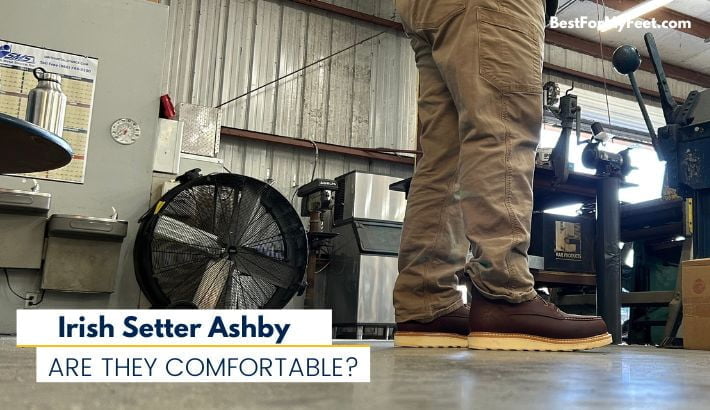
The slippage was exacerbated by the fact there are no speed hooks. Speed hooks allow you to tighten the laces snugly around the forefoot while keeping them comfortable around the ankles.
The Ashby doesn’t have speed hooks so I found myself not being able to tighten the boots as snuggly as I wanted without making it uncomfortable around the ankle.
Fortunately, there was a solution to my woes. I laced them two different ways, which are pictured below, to keep my foot secure while they broke in.
The first option involves not using the top two eyelets and wrapping the laces around the ankle to keep a secure fit.
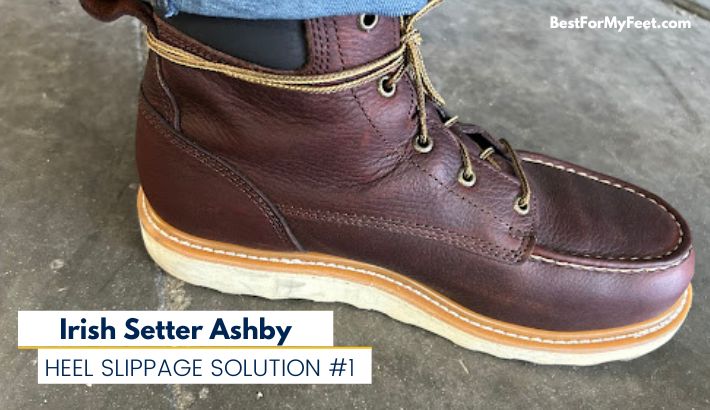
The second lacing system solution I’ve used and prefer is a heel lock. Heel locks are typically done with speed hooks but you can do them with eyelets too.
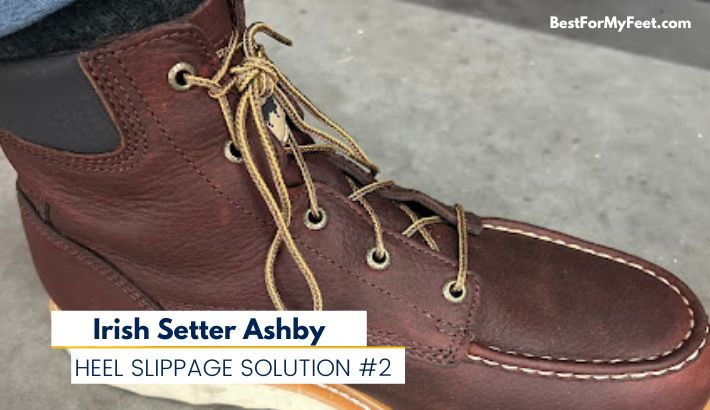
Are they waterproof?
No, the Irish Setter Ashby work boots are definitely not waterproof.
They lack a waterproof liner and without having a gusseted tongue they are very susceptible to getting water in them should you step in a puddle.
Since it’s dry here right now I filled a bucket to mimic stepping in a puddle.
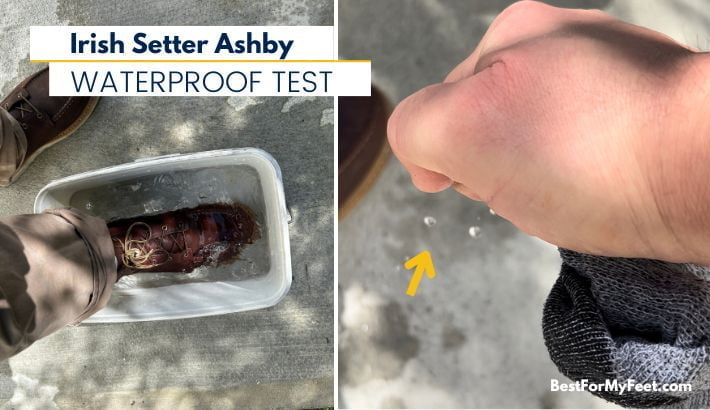
The result?
A wet sock. So these may not be the best option for you if you are in muddy and wet conditions a lot. Here are some waterproof work boots if that’s what you’re looking for.
Will the Irish Setter fit wide feet?
I’m confident they will. They come in D and EE sizes.
Red Wing measured my feet as an E width on their magic voodoo foot scanner and I decided to go with the D width and I have plenty of wiggle room for my toes.
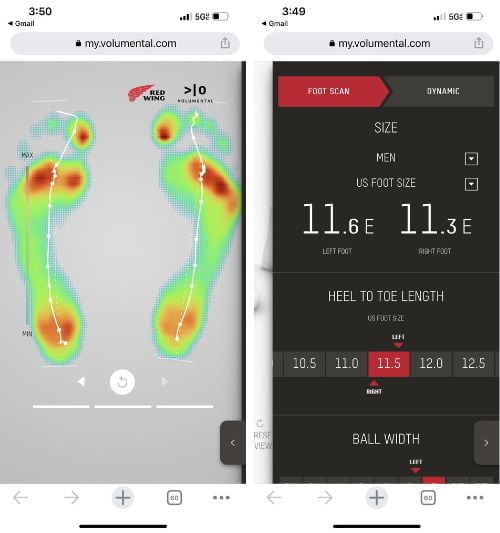
The standard D width is very roomy compared to other brands that tend to run very narrow.
Are they slippery?
I don’t personally have any issues with slipping in the Ashby boots.
However, I don’t work in an environment where slip hazards are a constant concern. These work boots are rated for slip resistance and meet ASTM F3445-21,SR requirements for slip resistance.
Where are they made?
According to the label of my work boots, the Irish Setter Ashby work boots are made in Vietnam.
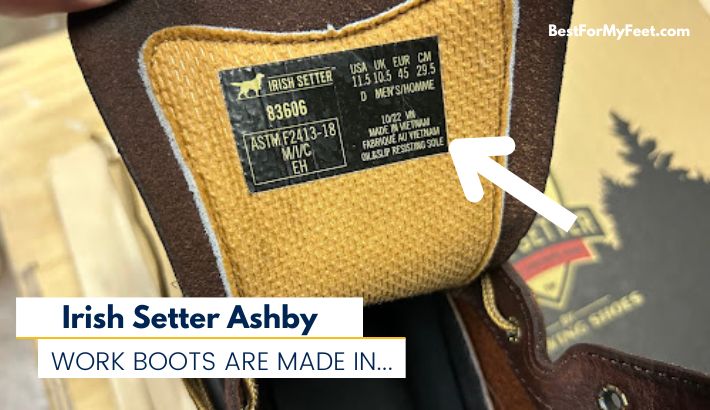
What others are saying about the Irish Setter Ashby boot?
Here are some of the things other owners of the Irish Setter Ashby work boots have commented about their boots:
Insanely comfortable
The boots are super comfortable, and 100% recommended.
Great looking boots
Some people don’t care about the aesthetics of the boots, they just need something on their feet in order to carry out a particular task or job.
If you’re one of those that do care if a boot looks good or stylish well these definitely get a lot of compliments.
They are like wearing slippers
Many comments on these Irish Setter Ashby work boots have to do with how lightweight they are. If you’re after a pair of lightweight safety work boots, the Ashby are a great option.
The tongue won’t stay centered
We know this from the section above where we talked about the tongue of the boot not being gusseted. The tongue flipping around and not staying centered is the consequence of not being gusseted.
This can drive crazy someone to the point of throwing them away the boots. I don’t know if that’s your case but it’s good to know before you spend your money on work boots you might not like.
Where to buy them?
You can get them at some brick-and-mortar stores such as your local Redwing store or you can also find them online on Amazon which is where I purchased mine or similar big box retailers.
Irish Setter Ashby work boots models available

| Model | Amazon | Zappos |
|---|---|---|
| Style 83652 (Black | Safety toe | 6″) | See in-store | See in-store |
| Style 83606 (Brown | Safety toe | 6″ | See in-store | See in-store |
| Style 83605 (Brown | Soft toe | 6) | See in-store | See in-store |
| Style 83908 (Brown | Safety toe | 9″ | Pull-On) | Irish Setter Store | – |
Some initial concerns
I have two concerns about possible weaknesses I see with this Irish Setter Ashby work boot that could affect their longevity.
First is the moc toe stitching. The moc toe is a two-piece stitch. With the top layer of leather wrapping over the toes and stitched across the front.
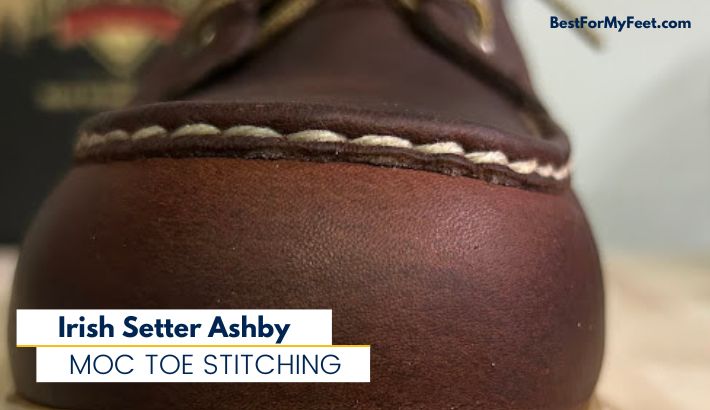
My concern is that if you drag your toes around a lot at work it will cause the toe box to fail as you’ll be dragging on the stitching directly.
The second is the synthetic welt. The concern here is the welt cracking making a resole costly and not worth it.
Watch the Ashby review on YouTube
Ashby compared to Wingshooter
A question that comes up a lot on the social media platforms we’re active on is what’s the difference between these two work boots, so we thought it might be helpful if we create an Irish Setter Ashby VS Wingshooter comparison article.
You can also watch us talking about it in this video on YouTube.
Last thoughts on these Irish Setter Ashby work boots
Despite my concerns, I think the Ashby is a solid work boot option.
If you’re in landscaping, excavation, new construction, and concrete work these boots may not be the best option for you.
But if you’re in an environment where you don’t have good chances of dirt debris entering your boots I think these are worth strongly considering.
The Ashby will work great for finish carpenters, mechanics, trades in a shop environment, commercial roofers, warehouse workers, etc.
Get Your Pair
Overall, A Very Comfortable Work Boot
Lightweight, safety toe caped, comfortable, wedge sole…these are some great features to have in a work boot. So far I’m very happy to wear these boots. Look out for the updates at the bottom of the page.

Update: Wearing the Irish Setter Ashby for 1 month
It’s been a little over a month since I started wearing the Ashby work boots and I really don’t have any complaints.
They’ve only gotten more comfortable thus far and I think I might just start calling them my shop slippers.
I’m seriously tempted to buy the soft toe version and make it a casual boot. Seriously, they are that comfortable.
My only concern is how well the leather will hold up in the toe area. The leather is extremely soft and supple, this is great for comfort but not always great for longevity.
Especially when pinned between two hard objects like the aluminum toe cap and a piece of metal. I’ve definitely put a few nicks and gouges in the toes so far.
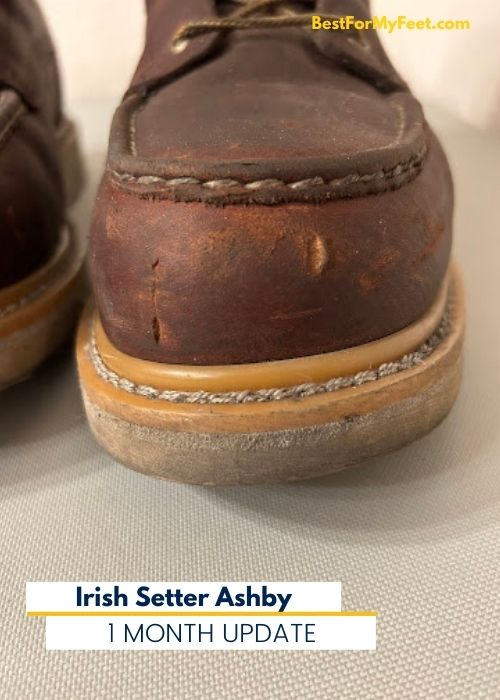
I’ve also picked up a leather gauge since I wrote the initial review, so I could check the thickness of the leather on the boots I’ve been reviewing and will be reviewing.

You’ll be happy to find out that the Ashby’s leather thickness came in at 2.68mm which is on par with more expensive work boots like Thorogood and is in the same range as the Red Wing heritage line.
Update: Wearing the Irish Setter Ashby for 6 months
Stay tuned, it’s coming soon…
Update: Wearing the Irish Setter Ashby for 12 months
Update: Wearing the Irish Setter Ashby for 24 months
Team Members Working On This Page

Adam Rich – Boots Tester & Reviewer
Hey, I’m Adam. I’m a welder and metal fabricator. Primarily doing aluminum tig and sheet metal fabrication. Spend most of the day on my feet on concrete floors in the shop with the occasional job site visit.

Victor Adrian – Editor And Webmaster
Construction Professional, driver, crane operator, cleaner, head chef … these are just some of the jobs I did in the past. Working in all these different environments taught me that having good footwear to protect your feet from different dangers at work IS PARAMOUNT for any worker! On this website, I aim to share all my knowledge and personal experience in dealing with different footwear and foot care issues, and hopefully, you can get something out of it. Enjoy!
Special Collaborator

Jaden Chavez – Goodyear welted boot collector
Hey, I’m Jaden. I work for a large American footwear brand in Central Texas. Outside of work, I love to collect vintage cowboy boots and Red Wing boots.


